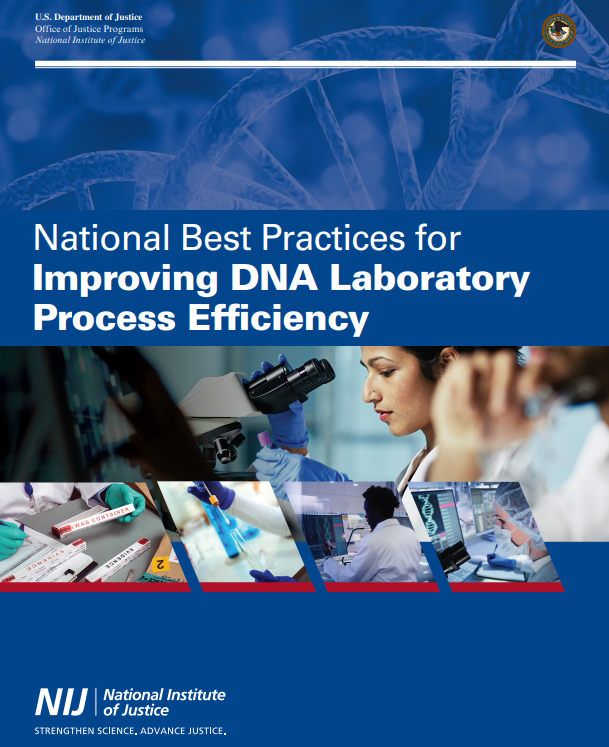In the mid-1980s, scientists unveiled a powerful new forensic tool that revolutionized the criminal justice system: DNA analysis. Over the past three decades, analyses performed by forensic DNA laboratories have identified countless suspects and exonerated the innocent. Today, with advances in technology making DNA analysis more accurate and more sensitive, DNA testing is used in criminal cases ranging from burglary to sexual assault and homicide. At the same time, forensic DNA laboratories have gained the capability to extract valuable information from even trace amounts of DNA and challenging biological samples.
As a result of their success, forensic laboratories are now inundated with a greater number of cases than ever before — along with a greater number of samples per case. Even as new techniques have shortened the processing time for DNA samples from months to days, laboratories often cannot keep pace with the vastly increased demand. Delays in analyzing samples due to the overwhelming workload may allow unidentified criminals to commit further crimes.
Although grants awarded by NIJ (and the Bureau of Justice Assistance starting in 2020) through the DNA Capacity Enhancement and Backlog Reduction Program have increased funding to DNA forensic laboratories, financial support is not enough to solve the problem. Laboratories overwhelmed by the demand for DNA testing must explore processes that will allow them to become more efficient. Even within the constraints of current budgets, laboratories can modify existing practices to operate more efficiently.
To that end, in 2018, NIJ commissioned a group of experts in forensic DNA analysis to research and write National Best Practices for Improving DNA Laboratory Process Efficiency. This guide brings together a combination of innovative and practical concepts, recommendations, and promising practices to assist DNA laboratories in increasing their productivity and capacity in a multitude of areas. These include onboarding and effective methodologies for staff training, efficient use and implementation of existing and advanced technologies and methodologies, the creation of strategies to improve process efficiency for casework, and the development of more efficient laboratory workflows. The guide provides forensic DNA laboratories with a roadmap for managing expected increases in case submissions due to stakeholder demand as well as less predictable impacts on caseload due to technological advances and legislative changes.
The recommendations in this guide are intended as best practices applicable to all laboratories with the understanding that the guidelines are not one-size-fits-all. Individual laboratories may have to adapt these recommendations based on funding, staffing, available technology, legislative requirements, local legal ramifications, and laboratory size.
Timeline: A History of Forensic DNA Evidence
Scientists first applied DNA technology to a criminal case in 1986, when police asked geneticist Alec J. Jeffreys of Leicester University in the United Kingdom to confirm the confession of a suspect who claimed to have committed one of two rape-murders in the English Midlands believed to have been committed by the same person. Forensic DNA testing revealed that the suspect had not committed either crime. The police then voluntarily obtained blood and saliva samples from nearly 5,000 men between the ages of 17 and 34 who lived in the region. Soon after the police learned that someone else had provided DNA samples for a man named Colin Pitchfork, he pleaded guilty to both crimes. “If it wasn’t for DNA, you might still be at large today, and other women would be in danger,” the presiding judge told Pitchfork.
Also, in 1986, U.S. prosecutors brought DNA evidence into the courtroom for the first time, using it to help convict a couple accused of murdering an elderly man in their care.[1]
DNA databases, which law enforcement authorities began building in the early 1990s, have expanded significantly over the years as it became clear that DNA was commonly left at crime scenes and that many suspects had offended repeatedly. U.S. investigators and analysts have come to rely on the Combined DNA Index System (CODIS), the national DNA profile repository maintained by the Federal Bureau of Investigation. All 50 states and the federal government have laws that require collecting DNA samples from people who are convicted of certain crimes and uploading the resulting DNA profiles to CODIS. Individuals who commit sex and violent offenses must give DNA samples upon conviction. Most states require collection of DNA samples from anyone who is convicted of a felony. The federal government and some states also require people arrested for certain crimes to provide DNA samples for the database, even if they are not convicted.
A 2008 study in the United States, commissioned by NIJ, found that burglary suspects identified through DNA evidence had at least twice as many felony arrests and convictions as suspects identified through traditional burglary investigations that did not include DNA.[2]
In the decade since that study was published, scientific and technical advances have made DNA analysis even more powerful, accurate, and timely. Training and proficiency testing of laboratory professionals have also improved. Driven by various forces — such as legal challenges to DNA evidence and its interpretation, the growing market for DNA- informed health and family services, and scientific breakthroughs — the level of certainty with which individuals can be identified and characterized using DNA samples of varying amount and quality has increased to a remarkable degree. It may not be surprising, then, that the demand for DNA forensic testing has outstripped the capacity of many laboratories. According to a U.S. Department of Justice report, the number of forensic biology casework requests received by publicly funded crime laboratories rose 28% from 2009 to 2014.[3] Data from NIJ show that state and local government laboratories participating in the agency’s DNA Capacity Enhancement and Backlog Reduction program have experienced a similar trend: From 2011 to 2017, the number of DNA submissions that were not processed within 30 days rose by 85% — even as the laboratories consistently processed more requests over time.[5]


